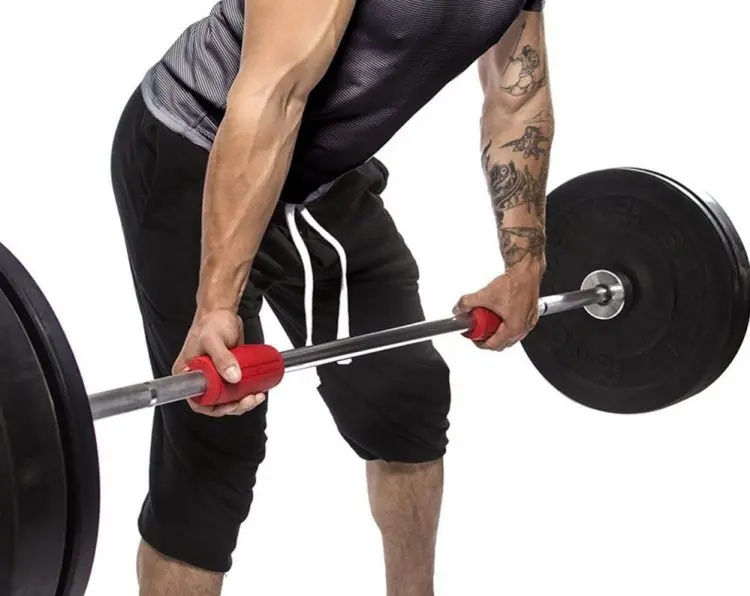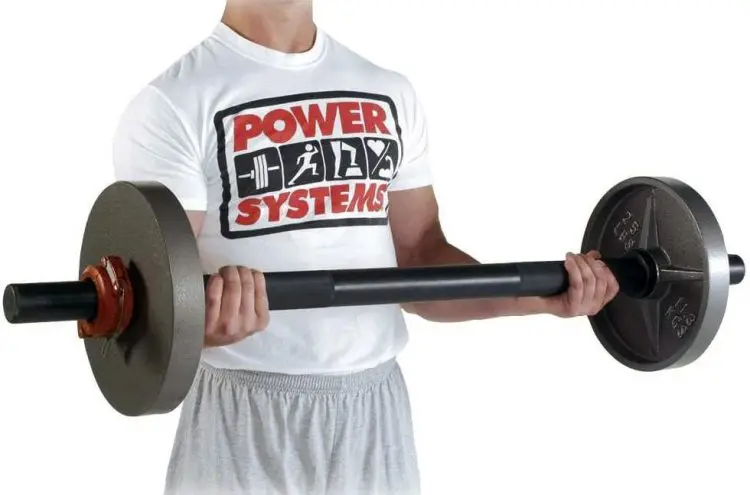Back in the golden age of strength training, old-school lifters trained with a wide range of equipment. They didn’t just use barbells and dumbbells. They lifted things like sandbags, rocks, and barrels too. When they did use barbells and dumbbells, they were not the sleek, perfectly balanced tools we use today.
They were often awkwardly large, unwieldy, and unbalanced. Many of these weights had thick handles, which made them even more challenging to work with.

That all changed with the rise in popularity of modern Olympic weightlifting. To create a level playing field, training equipment became standardized so that a barbell in the US was the same as one in China or the UK.
Slowly but surely, odd objects, weirdly sized weights, and other old-school training equipment gradually disappeared. Nowadays, gym equipment is pretty much all the same, with barbells, dumbbells, and resistance training machines being made to somewhat similar designs and dimensions.
However, like so many things in fitness and strength, many old-school training methods eventually resurface and become popular again. Kettlebells are one such example, and thick bar or fat grip training is another.
In this article, we explore the benefits of fat grip training and how best to incorporate this method into your workouts.
Level Up Your Fitness: Join our 💪 strong community in Fitness Volt Newsletter. Get daily inspiration, expert-backed workouts, nutrition tips, the latest in strength sports, and the support you need to reach your goals. Subscribe for free!
What is Fat Grip Training?
Standard Olympic barbells, as you’ll find in most gyms, are 7.2 feet long, weigh 45 pounds, and have a diameter of 1.1 inches. Barbells made for home or light recreational use tend to be shorter, lighter, and thinner. Dumbbell handles are also usually about an inch in diameter or a little less.
A thick or fat bar has, as the name suggests, a greater diameter, usually two inches or more.

With a one-inch bar, you can easily wrap your fingers around it, and your fingers will probably overlap. This creates a lot of friction for a firmer grip. With a fat bar, your fingers won’t overlap as much, if at all, and you’ll have to rely on hand strength only to maintain your grip.
There are thick barbells and dumbbells, and you can also buy clip-on handles to turn a standard barbell or dumbbell into a fat grip training tool. You can also use these handles on resistance training machines, such as lat pulldowns or chest presses.
No fat grip bars at your gym? Don’t want to buy some clip-on fat grips? No problem! You can achieve a similar effect by wrapping your bar with a towel or holding a sponge between your hand and the bar. This will temporarily increase the diameter of the bar.
The Benefits of Fat Grip Training
While all types of strength training are beneficial, adding fat grip training to your workouts could make things even more beneficial. Reasons to try fat grip training include:
Stronger grip and bigger forearms – if you want a cast-iron grip, training with a thick bar will give you what you want. Fat grip training turns every exercise into a grip builder. You’ll have to work much harder to maintain your grip on a thick barbell or dumbbells, and your hands will get stronger. In addition, all that extra grip training will increase forearm size, too.
Increased muscle activation – while using fat grips may mean you have to use lighter weights, using a thick barbell or dumbbells has been shown to increase muscle activation (1). This is due to a phenomenon called irradiation. In simple terms, the harder you grip, the more muscle fibers your body activates. Not just in your hands and forearms but throughout your body.
Increased strength – while using a fat bar or dumbbells will reduce the amount of weight you can use, your workouts will still be demanding and overload your muscles. When you return to standard bar training, your chosen exercises should feel considerably easier. In part, this will be because your grip is stronger, but also because exercises like curls and overhead presses are just more manageable with a regular bar.
Increased joint stability – with a less secure grip on your barbell or dumbbells, you’re going to have to work harder to stabilize the weight. This increases stabilizer muscle activity. Stabilizers are usually small muscles, such as the rotator cuff, that help prevent unwanted movement. Stronger stabilizers and better joint stability can increase exercise and sports performance which reducing your risk of injury.
Fewer aches and pains – using thicker barbells and dumbbells can help alleviate elbow pain. It takes stress off your tendons and could help prevent things like repetitive strain injuries, biceps tendonitis, and carpal tunnel syndrome.
Variety – your progress will soon stall if you do the same exercises over and over again. Fat grip training means you have another way to vary your workouts and keep you clear of training ruts and plateaus.
Level Up Your Fitness: Join our 💪 strong community in Fitness Volt Newsletter. Get daily inspiration, expert-backed workouts, nutrition tips, the latest in strength sports, and the support you need to reach your goals. Subscribe for free!
Fat Grip Training Exercises
The beauty of fat grip training is that you can apply this training method to almost any exercise. That said, if you are new to thick bar training, there are some exercises that are better than others.
Good fat grip training exercises include:
| Biceps curls | Overhead press | Bent over row | Romanian deadlift |
| Close grip bench press | Power clean | Single-arm row | Conventional deadlift |
| Skull crusher | Bench press | Upright row | Front squat |
| Zottman curl | Farmer’s walk | Kroc row | Walking lunge |
| Hammer curl | Floor press | Pendlay row | Step-up |
Whichever exercises you do, remember that you won’t be able to lift as heavy, so make sure you adjust your weights accordingly.
Fat Grip Training Dos and Don’ts
Get more from fat bar training by following these guidelines:
Do increase your reps
While you can use fat grip training for lower reps, you’ll probably get better results if you push things up to 12-20 reps per set. This will create a lot of metabolic stress and a strong pump effect, both of which will lead to better muscle growth.
Don’t try to build absolute strength
The best way to develop absolute strength is to lift heavy weights, usually 85% or more of your one-repetition maximum or 1RM. You won’t be able to lift such heavy weights with a thick bar, so fat grip exercises are really only suitable for bodybuilding and endurance training.
Do Use a spotter
Fat grip training makes it harder to hold the bar, so you are more likely to drop it when your hands get tired. That’s not much of an issue for bent-over rows or deadlifts but could be dangerous when doing bench presses, overhead presses, or skull crushers. Perform any high-risk exercises with a spotter on hand, who can take the weight from you if you start to lose your grip. Alternatively, do your fat bar exercises in a power rack.
Don’t forget to try finishers
Finishers, as the name suggests, are designed to finish off a target muscle group to stimulate maximal muscle growth. Finishers are also good for fat burning and building intestinal fortitude (gut!).
Thick bar training is ideal for finishers because even though you can’t use heavy weights, but whatever exercise you do will still be very demanding. Check out this example chest workout to see how you can use a thick bar to finish your training session on a high:
| Exercise | Sets | Reps | Recovery | |
| 1 | Bench press | 4 | 6 | 2 minutes |
| 2 | Incline dumbbell press | 3 | 8 | 90 seconds |
| 3 | Dumbbell flyes | 3 | 10 | 90 seconds |
| 4 | Chest press machine | 3 | 12 | 60 seconds |
| 5 | Thick bar bench press | 1 | 50* | N/A |
*Load up the bar with about 50% of your 1RM and crank out 50 reps in as few sets as possible. This is basically an extended rest/pause set.
Do introduce fat grip training gradually
While there is no denying that fat grip training is effective, that doesn’t mean you should forget about regular bar training and go all fat bar, all the time. Doing too much too soon could cause the very injuries that fat bar training is meant to prevent. Introduce fat bar training gradually to avoid unnecessary aches and pains.
Do stretch your forearms afterward
Fat grip training is very forearm-centric. Avoid tight forearms, which can cause wrist and elbow pain, by stretching your forearms afterward. An excellent way to do this is the “prayer” stretch.
Place your palms together in front of your chest. Slide your hands down while pressing the heels of your hands together and keeping your fingers straight. Hold for 20-40 seconds, and then relax. Repeat as necessary.
Fat Grip Training – Wrapping Up
Old-school lifters knew a thing or two about building muscle and functional strength. They didn’t use machines and, instead, focused almost exclusively on free-weight exercises. Many famous lifters also used odd objects to challenge and build strength and embraced training tools designed to make their workouts harder.
Fat grip training was very common in those days, and it’s no coincidence that most old-school lifters also had incredible grip strength.
So, whether you want to build bigger, more muscular forearms, increase stabilizer strength, or just add some variety to your workouts, thick bar training can help.
References:
1 – PubMed: Impact of Fat Grip Attachments on Muscular Strength and Neuromuscular Activation During Resistance Exercise https://pubmed.ncbi.nlm.nih.gov/30694963/




